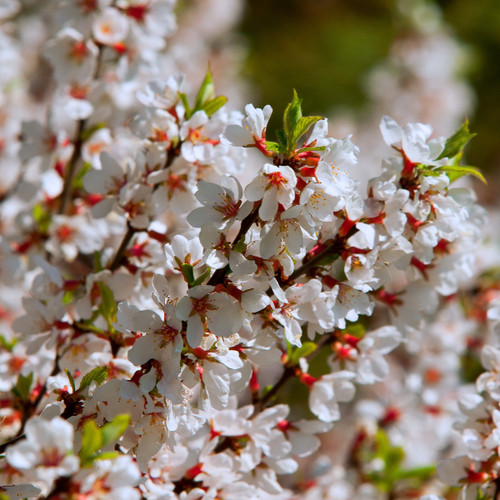Cannot Ship To:AK,CA,HI
Please Read Our Store Policies HERE Before You Order!!
Introduction:
The Choke Cherry Tree (Prunus virginiana) is a hardy, deciduous tree or shrub known for its fragrant white flower clusters and small, tart, dark purple berries. Native to North America, the Choke Cherry is a popular choice for naturalized areas, wildlife gardens, and hedges. While the berries are too sour to eat fresh, they can be used to make jams, jellies, and syrups. The tree also provides excellent habitat and food for birds and other wildlife.
Plant Summary:
- Size: Grows to a height of 20-30 feet with a spread of 15-25 feet.
- Foliage: Glossy green, oval-shaped leaves turn yellow or red in the fall.
- Flowers/Fruit: Clusters of fragrant white flowers in spring, followed by small, dark purple berries.
- Growth Habit: Upright, spreading habit with multiple stems or a single trunk.
- Sunlight: Prefers full sun to partial shade.
- Soil: Thrives in moist, well-drained soils but tolerates poor, dry soils.
- Hardiness: Hardy in USDA Zones 2-7.
- pH Level: Prefers slightly acidic to neutral soils (pH 5.5 to 7.0).
- Pruning: Prune in late winter to shape the tree and remove dead or damaged branches.
- Pests/Diseases: Susceptible to black knot, aphids, and tent caterpillars.
Pollination:
The Choke Cherry Tree is self-pollinating, meaning it does not require another tree to produce fruit. Pollinated primarily by bees and other insects, the fragrant white flower clusters bloom in spring and attract beneficial pollinators to the garden. The small, dark purple berries that follow in summer are a valuable food source for birds and wildlife. While self-fertile, planting multiple trees can improve fruit production.
Key Benefits:
- Produces small, tart berries that can be used in jams, jellies, and syrups.
- Fragrant white flowers attract bees, butterflies, and other pollinators.
- Provides food and habitat for birds and other wildlife, supporting local ecosystems.
- Hardy and adaptable to a wide range of soil types, including poor or dry soils.
- Beautiful fall foliage adds seasonal color to the landscape.
Care Instructions:
- Light: Prefers full sun to partial shade for optimal growth and fruit production.
- Water: Keep soil consistently moist, especially during dry periods.
- Soil Type: Thrives in well-drained soils but adapts to a variety of soil types, including poor soils.
- Pollination: Self-pollinating, though planting multiple trees improves yields.
- Growth Rate: Fast-growing, reaching maturity in 10-15 years.
- Max Height/Width: Reaches 20-30 feet in height and 15-25 feet in width.
- Pruning: Prune in late winter to remove deadwood and shape the tree.
Why You'll Love It:
The Choke Cherry Tree is a versatile and resilient tree that provides both beauty and practical benefits. Its fragrant spring blooms attract pollinators, while its tart, dark purple berries are perfect for making jams, jellies, and syrups. The tree also provides valuable habitat and food for birds and wildlife, making it an excellent choice for naturalized areas and wildlife gardens. Its adaptability to a variety of soil types and growing conditions makes it a reliable choice for even the most challenging landscapes.
Planting Tips:
Plant your Choke Cherry Tree in early spring or fall in a sunny location with well-drained soil. Dig a hole twice as wide as the root system and plant at the same depth it was growing in the nursery. Water thoroughly after planting and mulch around the base to retain moisture and suppress weeds. Regular watering during the first few years will help establish a strong root system and promote healthy growth.
Shipping Details:
Your Choke Cherry Tree will be shipped as a bare root plant, carefully packaged to ensure it arrives in optimal condition. Bare root plants are shipped during dormancy to promote successful transplanting and establishment in your landscape.
11 Reviews Hide Reviews Show Reviews
-
Nice little plants
Lovely little trees I was very pleased. I’m always nervous ordering from a new place but my shipment arrived at a good time, in good condition and nice little trees. I was surprised to see the roots even had moisture retaining gel crystals on them and no dried out roots at all.
-
Chokecherry tree’s
Ordered 3 tree’s and was provided with 4. Shipment arrived quickly with tree’s packaged very well with extra effort paid to maintaining moisture on bare roots. Quality of small tree’s was excellent. Time will tell how they do but the tree store did their part well!









